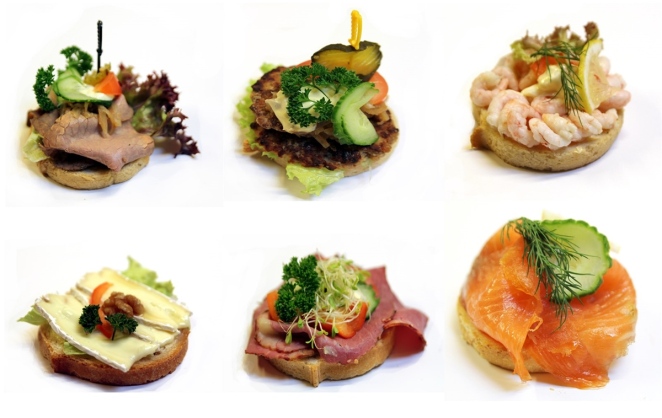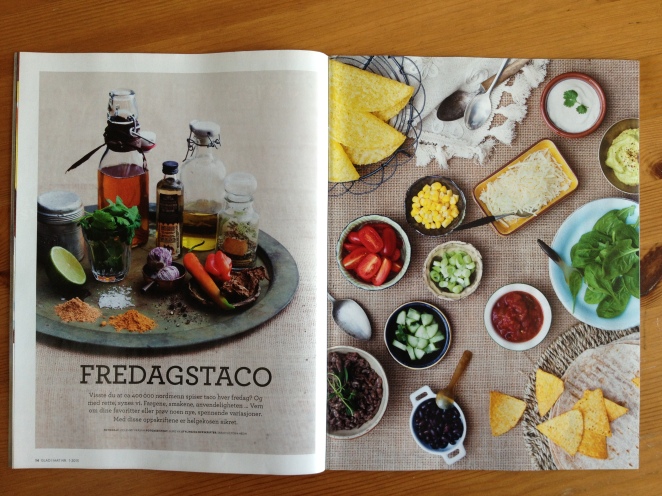Our palates are obviously culturally biased, even in our day and age, with international food trends and true cosmopolitan dinner habits. Very broadly one can say that Americans like it sweet, South-East Asians like it spicy, and Norwegians want it salty. A quick look at classic American and Norwegians breakfast habits illustrates this well: Norwegians seems to prefer grainy bread with hard cheese, salty cold cuts, hard-boiled eggs with roe and mackerel in tomato sauce. Americans like eggs too, and bacon, but preferably paired with something sweet: pancakes, waffles, coffee cake, muffins; typically the kinds of things that Norwegians would reserve for an afternoon coffee break. Americans have made an art of the cooked breakfast, and you’ll find elaborate omelets, breakfast casseroles, huevos rancheros with beans or skillet dishes with potatoes. If a Norwegian were to cook anything for breakfast, it’d be boiled, scrambled or fried eggs, possibly with bacon, but nothing more elaborate than that. You will find orange juice on the table in both countries, but here is something that has struck me: Orange juice always tastes sweeter in the US than it does in Norway, even when the Norwegian juice is made from Florida oranges.
Comparing nutritional values takes an engineering degree, or at least a clear head and a good calculator, as American charts show grams per serving, which is in ounces, and I am always tempted to give up right then and there, but I’ll stick with it here – if nothing else, so to illustrate how ridiculous American food labeling is. Norwegian orange juice has 9.1 g of sugar per 100 g (Sunniva from Tine), whereas American (Minute Maid) has 27 g carbs, of which 24 g are sugars, per 8 fl ounces/240 ml. 64 fluid oz of orange juice weighs 68.8 oz, which is 4 pounds, 4.5 oz (but I guess it to an extent depends on the amount of pulp). Anyway, based on this, 8fl oz should weigh 8.6 oz, which is 243 grams. We then need to divide the 24 g sugar with 2.43 to get the number per 100 g, and the answer is 9.87. Not a huge difference, I must admit, but I’d be interested in doing a side by side taste test to confirm my suspicion. I am willing to bet that American juice IS sweeter! (Could it have something to do with the freshness of the oranges when squeezed? Or is this about the flavor packs; i.e. what the producers add back into the juice after it has been concentrated and deoxygenized? This is a mystery, and I would appreciate any information from astute readers.)
But sweet vs. salty is one thing; my main objective here was to look at some more specific flavors. Here are some things I have noticed:
Cough medicine
American medicines are normally flavored with grape (for kids), cherry (for kids or grownups) or wintergreen (grownups only). It doesn’t matter what it is, if it is cough syrup or painkillers, or which brand – this is basically what you have to choose between. That fake cherry flavor could follow you through your whole American life, in fact: From Shirley Temples and fruit punch, via your medicine, to that dessert Maraschino cherry on top of your ice cream. The cherry love has found its way onto language as well: Life is just a bowl of cherries, says the song; young men all want to be the one to pop the cherry of their sweetheart; and most of us are guilty of cherry-picking at one time or another. Go figure.
In Norway, on the other hand, the flavor for cough syrup is licorice, or rather anise, as Norwegian licorice is black and anise flavored where the American one is red and either strawberry or – wait for it – cherry flavored!
And Norwegians like their licorice salty (surprise!). You’ll find the sweet black kind as well, but salty licorice is by far the more popular. I guess that fits with the general preference for salty.
Raspberries
Raspberries are popular in the US, and I was surprised the first few times I ate in restaurants where they included raspberries in savory dishes. Maybe mostly a southwest/New Orleans thing, though? But a raspberry vinaigrette is a common salad dressing; a raspberry and balsamic marinated chicken breast is maybe less common, but you’ll find several varieties of this recipe online. Then there’s the classic tortellini salad with raspberries. In Norway they settle for making jam from their raspberries – and you can eat a slice of grainy bread with raspberry jam at the end of breakfast, as your “breakfast dessert”, but it would probably be frowned upon if that was all you had.
Cucumbers
I don’t know when Norwegians fell in love with cucumbers, but at some point they obviously did. Rare is the sandwich that doesn’t have cucumber on it. It might have been the malleability, the fact that you could cut this really thin slice and then twist and bend it to make it look festive, that first help the cuke earn its place in Norwegian café culture. And they grow pretty easily, even in a cold climate, so they are readily available year round. The illustration below shows some Norwegian sandwich classics – I believe 4 of the 6 here have cucumber slices on them. (Some would put cucumber slices on the shrimp sandwich too, but I guess you rarely see it with the brie. Thankfully.)

The picture is borrowed from Vaaland Dampbakeri
And it is of course the classic accompaniment to salmon – in the shape of the wet cucumber salad.
Seen from afar though, I find a more modern gastronomical application of the cucumber even more fascinating. At some point the past twenty years, tacos became to go-to food for Norwegian families on Friday night. I don’t know exactly how widespread it is, but judging from references in media and my Facebook feed, it is very common. The caption on the illustration below says 400 000 Norwegians eat tacos every Friday, and that seems about right. On its way from Mexico/USA the taco has gone through some transformation; this is the typical Norwegian taco filling line-up:
Taco flavored ground beef, cheese, salsa, tomatoes, lettuce, corn, fresh red peppers, onions, and – yes! – cucumber. ¡Hola!

Cardamom
Cardamom has been a popular flavor in Norway for I don’t know how long, but it goes way back. Obviously this is an import from faraway places, but it found a home there up north. Norwegians like it in both savory and sweet food. Norwegian meatballs are flavored with cardamom, as are sausages. And the ubiquitous sweet wheat bun that they sell in every bakery, grocery store and convenience store, seems to have gradually gotten more “cardamommy”: I used to love those – for Norwegian kids that was and still is the standard “everyday” treat – but now I can’t eat them anymore, as the cardamom taste has gotten too strong for me. Most people also flavor their waffles with cardamom.
The stronger cultural impact of cardamom you actually find in a book: The children’s book writer Thorbjørn Egner wrote a book called “Folk og røvere i Kardemomme by” (People and robbers in Cardamom Town), which has become a classic. It is set somewhere exotic, from the descriptions and illustrations it could be Morocco or somewhere like that, but the story is very Norwegian (about these three robbers who kidnap a strict lady to clean for them, but she takes control and makes them clean up and do all the work, so they end up taking her back). In the book, the Cardamom Law is formulated, and it reads something like this: You must not bother other people, you need to be kind, but otherwise you can do what you want. Any Norwegian can cite this Law; it forms a moral backbone of the Norwegian character. There is now a theme park called Cardamom Town in the south of Norway. This is the import that clearly had an impact, beyond the flavor of the day.
Cheese
Americans love cheese so much it seems to be on everything, especially if it is melted. Partly that must be due to the strong Italian American culture, which is large and influential beyond the ethnic group. Pizza? Pasta Alfredo? Lasagna? Even diet outfits like Jenny Craig and Nutrisystem seem to have cheese on most of their dishes, and you can find stuff like the powdered cheese and bacon omelet from HealthSmart, supposedly a diet food, at 100 calories per pouch. Yes, it is pretty counter-intuitive, but I guess cheese is hard to give up. (I never had any of this so-called diet food myself, but I find it interesting to look at what they offer, as they are trying to appeal to the mainstream taste preferences.)
There’s cheese on burgers, cheese in salads, cheese in hot dogs, grilled cheese sandwiches and a hundred other uses. And cheesecake, of course.
(In addition to cheese, and sometimes instead of cheese, you also have “cheese”, like American cheese – which probably wouldn’t be called cheese by anyone who is not American. And Easy cheese. Oh, how cheesy can it get???)
Americans like to serve French cheeses as an appetizer, whereas the French wouldn’t dream of serving it until after the meal. Otherwise, Americans seem to prefer their cheese melted – whereas Norwegians like theirs sliced. Thinly, because you need to be frugal. So you use a cheese slicer, apparently one of the few Norwegian inventions in our world of tools. (The cheese slicer is also useful when you make the cucumber salad, btw.)
Growing up in Norway, there was yellow cheese (Norvegia or Jarlsberg) and brown cheese (sweet goat cheese), and something called Key cheese (Nøkkelost), which is a Swiss type cheese flavored with cumin and cloves. That was pretty much it. These days the brown goat cheese is banned in some Norwegian daycare centers and schools, as they consider it too sweet to be healthy for the kids, but the cheese is so popular it will probably survive anyway. Even if, or maybe because, it only has 10% goat milk in it. The rest is cow’s milk; boiled to a caramel-like color and consistency. Very nice on your waffles, for the afternoon coffee break, but maybe not really cheese?
Charles de Gaulle famously said, How can you govern a country which has two hundred and forty-six varieties of cheese? Based on that, Norway shouldn’t be too hard to govern. What it says about America, though, I do not know. Maybe it doesn’t say anything about that.
If anyone is interested in and would like to read more about the orange juice flavor pack phenomenon, I can recommend this excellent blog post: http://www.foodrenegade.com/secret-ingredient-your-orange-juice/
LikeLike